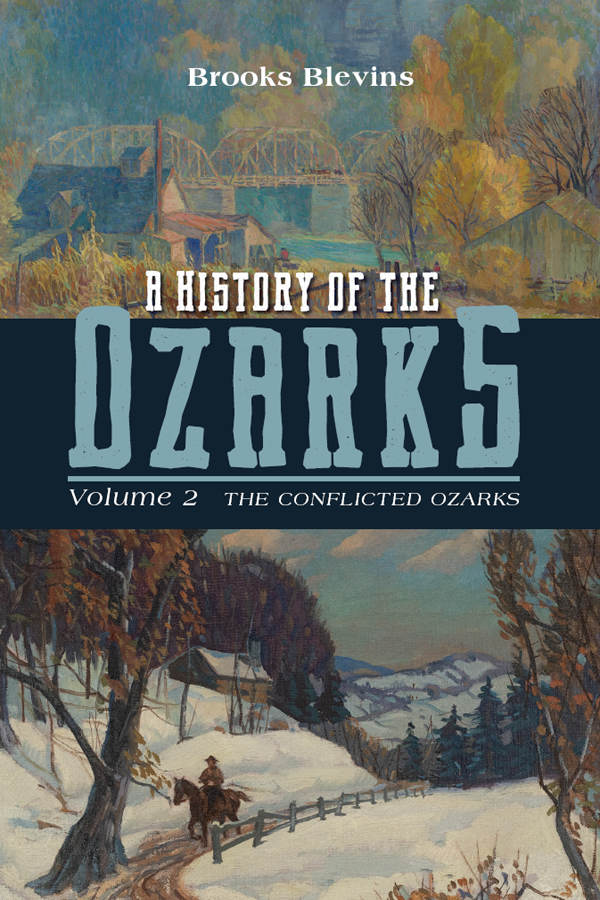Brooks Blevins’ A History of the Ozarks Vol. 2: The Conflicted Ozarks is a worthy follow-up to Vol. 1, The Old Ozarks, which recounted Native American and early European and African settlement in the region, leaving the Ozarks on the eve of the Civil War.
Vol. 2 opens with a chapter on slavery in the Ozarks—the importance of which, Blevins asserts, historians have largely dismissed because of the relatively small enslaved population in the region. The author points to historian Ira Berlin’s dichotomy between slave societies and societies with slaves, noting that the Ozarks was a society with slaves with “pockets of slave society” in population centers such as Fayetteville, Arkansas, and Springfield, Missouri, as well as Missouri’s lead-mining areas (13). The distinction, however, “may have boiled down to perspective” (14). White Ozarkers largely lived in areas where slavery was economically and culturally peripheral, but enslaved black Ozarkers “typically found themselves in a place that resembled a slave society” (14). Regardless of their direct involvement in the institution, Ozarkers knew the importance of national debate over slavery, which wracked the region in the final years before the slaveholders’ rebellion.
The chapters covering the Civil War years in the Ozarks are outstanding. The stories of Wilson’s Creek, Pea Ridge, and Prairie Grove have been exquisitely detailed in other works. Blevins tells the stories of common Ozark folk and the momentous hardships they faced during the war years. This book is not a military history, nor does it need to be, although Blevins’ summaries of key military events are admirable. He notes that the conventional war between U.S. and rebel armies had been effectively decided by the end of 1862, but that moment only marked the beginning of another war, “one eminently more dangerous to civilians and more disruptive to the social fabric of the Ozarks” (85). Partisans of all affiliations stole, destroyed, and murdered, whether for the sake of the Union or Confederate cause, or merely out of a desire to settle old scores. Blevins’ chapter on the guerrilla war in the Ozarks may be the best yet written on the subject.
One of this book’s key strengths is Blevins’ emphasis on the continuity of violence in the Ozarks, from the Kansas Border War of the 1850s, through the guerrilla war of the Civil War years, to the continuing violence perpetuated by the Ku Klux Klan and pro-Republican groups such as Taney County, Missouri’s Bald Knobbers. The immediate postwar years saw the political ascendancy of the Republican Party in both Missouri and Arkansas, which Blevins argues “bred an atmosphere in which Unionists often felt free to harass, persecute, and even kill returning rebels” (140). Former Confederates responded in kind, especially after Democrats returned to power in the 1870s. The cycle of violence continued as it had for years before and during the war, its causes only becoming more complex. “More than ever before,” Blevins notes, “in the years following the Civil War men turned to weaponry and violence to settle political disputes, to enforce or flaunt community justice and moral codes, to handle personal vendettas, and to assist or resist civil authority” (173).
The Conflicted Ozarks is a superb study of a fascinating region during a tumultuous period of destruction and rebuilding. It is one of the better books yet written on the Civil War in the Trans-Mississippi. Blevins tells the compelling story of the Ozarks and its people, showing that twentieth century stereotypes about Ozarkers resulted in large part from the trauma of the latter half of the nineteenth century. As Blevins concludes, “The long era’s destruction, chaos, and lingering enmities disrupted the region’s social and economic development, forcing a prolonged recovery that delayed the maturation of some places by a quarter century or more and bequeathed to postwar generations poverty, uncertainty, and want” (235). This work will be of interest to Civil War scholars, especially those who study the Trans-Mississippi, as well as anyone interested in the Ozarks as a region. Appalachian scholars should also read this book to find a region ripe for comparative studies.
Roy Wisecarver is a Ph.D. student in the Department of History at Texas A&M University.





